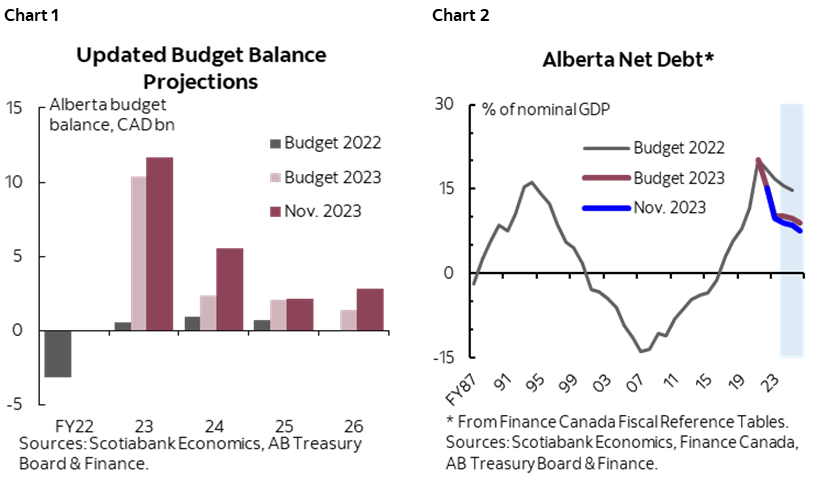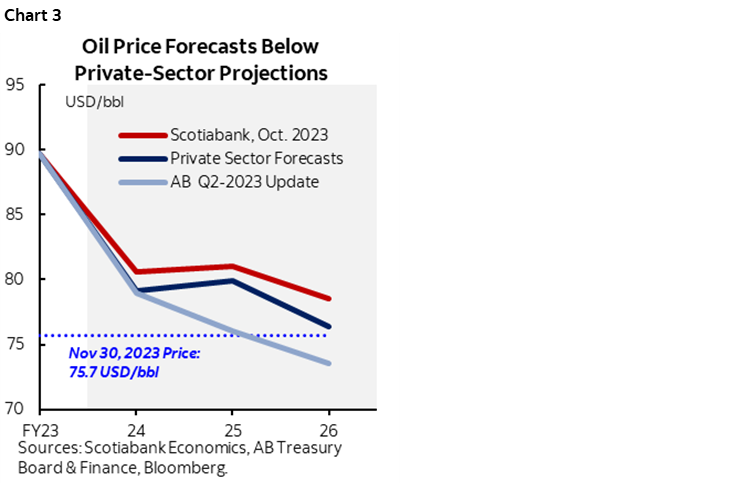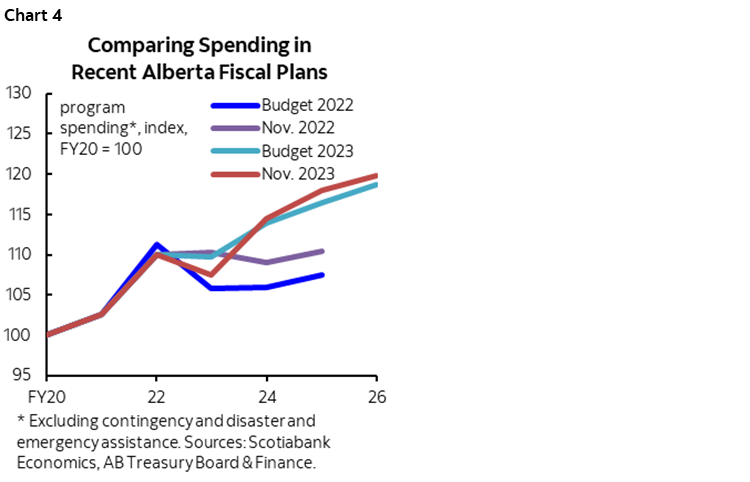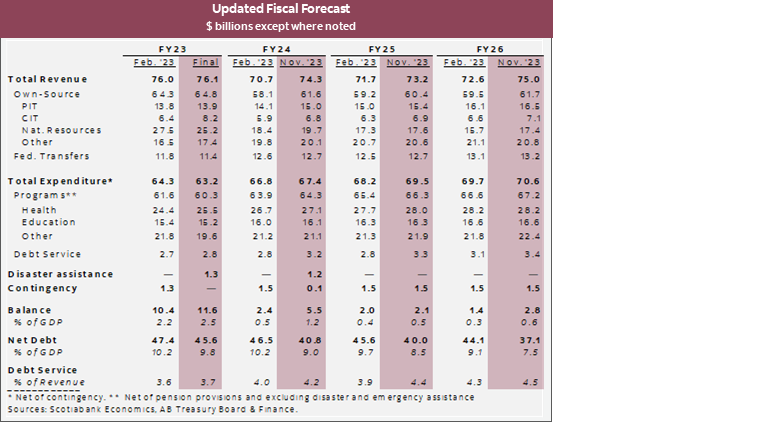ON SOLID GROUND
- Budget balance forecasts: $5.5 bn (1.2% of nominal GDP) in FY24, $2.1 bn (0.5%) in FY25, $2.8 bn (0.6%) in FY26, respective improvement of $3.2 bn, $0.1 bn, and $1.4 bn versus Budget 2023 (chart 1).
- Net debt: revised down by an average of $6 bn each year through FY26; as a share of nominal output, net debt is now expected to decline steadily from 9.8% in FY23 to 7.5% by FY25 (chart 2).
- Economic forecasts: nominal GDP forecast nudged down from -2.2% to -2.3% for 2023 but lifted from +3.5% to +3.9% for 2024; WTI price projections unchanged at US$79/bbl in FY24, US$76/bbl in FY25 and US$73.5/bbl in FY26.
- Borrowing requirements: not updated but with a $3.2 bn improvement in the budget balance, the program should come in much lower than the $6.7 bn forecast for FY24 at Budget time.
- Capital spending: planned outlays are projected to total $7.7 bn in FY24, $8.3 bn in FY25 and $7.2 bn in FY26—a total of $211 mn increase from Budget 2023 over the three fiscal years.
- Alberta solidifies its prominent standing in provincial public finances with a prudent plan that exercises spending restraint. The commitment to dedicating a larger cash surplus ($3.2 bn versus $1.4 bn in Budget 2023) towards repaying maturing debt is commendable. Oil price assumptions appear reasonable particularly with recent supply-side politics supporting oil prices. It is nevertheless crucial to acknowledge the province’s fiscal sensitivity to volatile oil prices, as fluctuations in energy prices and light-heavy differentials could significantly impact the outlook.
- The recently unveiled Alberta Carbon Capture Incentive Program (ACCIP), designed to facilitate the development of new carbon capture, utilization and sequestration (CCUS) projects in the province, is not included in this update. The incentive program is expected to help attract $35 bn in capital investment with an estimated cost between $3.5 bn and $5.3 bn.

OUR TAKE
Alberta’s mid-year update projects notable current-year improvement followed by modest upward revisions in each of the next two years. Driven by revenue gains across various sources, the province is estimating a $5.5 bn (1.2% of nominal GDP) surplus for FY24, followed by two years of surpluses of around 0.5% of nominal output. This comes on the heels of a hefty $11.6 bn surplus (+2.5% of nominal GDP) in FY23—$1.3 bn higher than anticipated in February. With the bulk of the surplus cash designated for debt repayment, debt levels are projected to edge down from a lower starting point as a share of output than anticipated in Budget 2023, reinforcing Alberta’s advantage over other provinces. Net debt is projected to edge down to 9.0% of GDP in FY24 before steadily declining to reach 7.5% by FY26—far lower than all provinces’ latest estimates.
The revenue upside is not surprising given Alberta’s favourable economic and labour conditions, supported by robust energy prices. Own-source revenues are expected to surpass budget estimates by $3.5 bn (6%), with the increase evenly distributed between non-renewable resource revenue and tax revenue. Bitumen royalties—accounting for about 70% of resource revenue— are tracking $1.8 bn higher than Budget 2023 projection, driven by a tighter light-heavy differential, a weaker Canadian dollar and an additional oil sand reaching payout this year. Both the personal income tax (PIT) and corporate income tax (CIT) benefit from a stronger starting point following the 2022 tax assessments, projecting a combined improvement of $1.8 bn.
Granted, the economic assumptions underpinning the current plan appear optimistic. Real GDP is expected to grow by 2.8% this year and 2.6% next year, while nominal GDP is projected to contract by -2.3% this year before rebounding by 3.6% next year. These are very optimistic growth figures that surpass our current projections, where we expect the Alberta economy to grow by 2.3% in real terms this year and a more moderate rate of 1.2% next year.
Largely unchanged from Budget 2023, oil price assumptions are in line with expectations for current year, and more conservative in outer years (chart 3). The WTI price assumption remains unchanged at US$79/bbl in FY24 and the light-heavy differential was revised down from US$19.5/bbl to US$17/bbl—both are very close to the averages so far this fiscal year. Despite crude prices being a wildcard, the completion of the Trans Mountain Pipeline Expansion (TMX) in early 2024 will boost egress for Alberta, keeping light-heavy differentials tight. The update assumes WTI prices to gradually moderate in FY25 and FY26 to an average of US$76/bbl and US$73.5/bbl, respectively—more conservative than the private-sector averages and Scotiabank’s latest forecasts for both years, signalling prudent planning given the high sensitivity to oil prices. As a rule of thumb, a US$1/bbl change in WTI price is linked with a net fiscal impact of $630mn for Alberta.

The update largely maintains the spending plan in Budget 2023 with incremental new spending added (chart 4). The $1.2 bn expense increases in disaster and emergency assistance costs linked to the unprecedented wildfire season almost depleted the $1.5 bn spending contingency set aside at budget time. The updated fiscal plan maintains $1.5 bn in contingency and disaster assistance each year from FY25 to FY26. Regular program spending only saw a modest $341 mn increase relative to the budget, with another $309 mn expense increase coming from debt service costs.

Alberta’s FY24–26 Capital Plan is now expected to total $23.2 bn, $211 mn more than anticipated in Budget 2023. In FY24, planned outlays decreased by $261 mn versus Budget, driven by re-profiling of cash flows to future years due to project delays.

DISCLAIMER
This report has been prepared by Scotiabank Economics as a resource for the clients of Scotiabank. Opinions, estimates and projections contained herein are our own as of the date hereof and are subject to change without notice. The information and opinions contained herein have been compiled or arrived at from sources believed reliable but no representation or warranty, express or implied, is made as to their accuracy or completeness. Neither Scotiabank nor any of its officers, directors, partners, employees or affiliates accepts any liability whatsoever for any direct or consequential loss arising from any use of this report or its contents.
These reports are provided to you for informational purposes only. This report is not, and is not constructed as, an offer to sell or solicitation of any offer to buy any financial instrument, nor shall this report be construed as an opinion as to whether you should enter into any swap or trading strategy involving a swap or any other transaction. The information contained in this report is not intended to be, and does not constitute, a recommendation of a swap or trading strategy involving a swap within the meaning of U.S. Commodity Futures Trading Commission Regulation 23.434 and Appendix A thereto. This material is not intended to be individually tailored to your needs or characteristics and should not be viewed as a “call to action” or suggestion that you enter into a swap or trading strategy involving a swap or any other transaction. Scotiabank may engage in transactions in a manner inconsistent with the views discussed this report and may have positions, or be in the process of acquiring or disposing of positions, referred to in this report.
Scotiabank, its affiliates and any of their respective officers, directors and employees may from time to time take positions in currencies, act as managers, co-managers or underwriters of a public offering or act as principals or agents, deal in, own or act as market makers or advisors, brokers or commercial and/or investment bankers in relation to securities or related derivatives. As a result of these actions, Scotiabank may receive remuneration. All Scotiabank products and services are subject to the terms of applicable agreements and local regulations. Officers, directors and employees of Scotiabank and its affiliates may serve as directors of corporations.
Any securities discussed in this report may not be suitable for all investors. Scotiabank recommends that investors independently evaluate any issuer and security discussed in this report, and consult with any advisors they deem necessary prior to making any investment.
This report and all information, opinions and conclusions contained in it are protected by copyright. This information may not be reproduced without the prior express written consent of Scotiabank.
™ Trademark of The Bank of Nova Scotia. Used under license, where applicable.
Scotiabank, together with “Global Banking and Markets”, is a marketing name for the global corporate and investment banking and capital markets businesses of The Bank of Nova Scotia and certain of its affiliates in the countries where they operate, including; Scotiabank Europe plc; Scotiabank (Ireland) Designated Activity Company; Scotiabank Inverlat S.A., Institución de Banca Múltiple, Grupo Financiero Scotiabank Inverlat, Scotia Inverlat Casa de Bolsa, S.A. de C.V., Grupo Financiero Scotiabank Inverlat, Scotia Inverlat Derivados S.A. de C.V. – all members of the Scotiabank group and authorized users of the Scotiabank mark. The Bank of Nova Scotia is incorporated in Canada with limited liability and is authorised and regulated by the Office of the Superintendent of Financial Institutions Canada. The Bank of Nova Scotia is authorized by the UK Prudential Regulation Authority and is subject to regulation by the UK Financial Conduct Authority and limited regulation by the UK Prudential Regulation Authority. Details about the extent of The Bank of Nova Scotia's regulation by the UK Prudential Regulation Authority are available from us on request. Scotiabank Europe plc is authorized by the UK Prudential Regulation Authority and regulated by the UK Financial Conduct Authority and the UK Prudential Regulation Authority.
Scotiabank Inverlat, S.A., Scotia Inverlat Casa de Bolsa, S.A. de C.V, Grupo Financiero Scotiabank Inverlat, and Scotia Inverlat Derivados, S.A. de C.V., are each authorized and regulated by the Mexican financial authorities.
Not all products and services are offered in all jurisdictions. Services described are available in jurisdictions where permitted by law.

